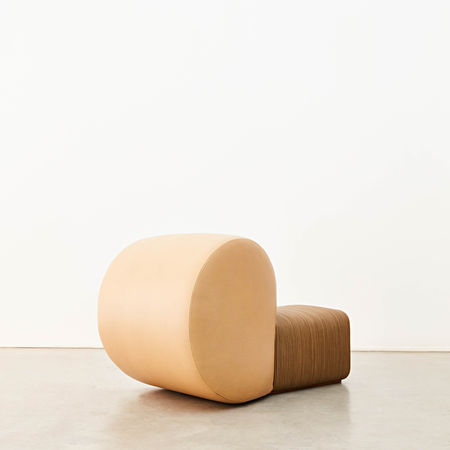
AMBIGUITY ENGINES
ABOUT DESIGN WITH EELKO MOORER
BY ANDREA BRIATTA
In a world filled with sleek surfaces and ruled by function, Eelko Moorer’s work feels like a threshold. Like looking at something not yet fully defined. Moorer’s objects vibrate in ambiguity, resisting easy categorization. A chair becomes an armadillo; a shoe turns into a cocoon. This isn’t just poetic language, it’s the very heart of the work.
Originally trained as a footwear designer, Moorer has never truly left that world behind. His early shoes, worn by Björk, resembled soft armours, sculpted and textured. They were meant to be touched. Later experiments at the Royal College of Art and beyond evolved into object-furniture hybrids. Seats you could wear. Tables you could walk in. In a sense, his entire practice stems from that moment when an object becomes more than what it’s supposed to be. In Moorer’s hands, design is not something finished and still, but something animate, charged, slippery. A process of becoming.
His approach is deeply influenced by the body, its performativity, its contradictions. He talks about chairs as prosthetics, mirrors as doubles, about the moment when furniture stops being inert and becomes an extension of ourselves. That’s the field that spans accessories, jewelry, and footwear, and quickly veered toward the subversive. One of his best-known chairs is made of cast rubber and wood, with radical lines and rebellious softness. It looks like a cartoon muscle or a villain’s throne. “I wanted to create something that makes you stop. That’s slightly off. That you don’t know what to do with, but still want to touch,” he says. These pieces ask to be felt, to be inhabited, to be held. They look like creatures. They’re skins. They’re interruptions. They’re mirrors with just enough steam to blur the reflection. What remains depends on the viewer and dust.
Moorer teaches design at the Royal College of Art in London and at the Design Academy of Eindhoven. This doesn’t come as a surprise. All his projects, from chairs to prints to mirrors, feel like exercises in perception. They ask questions more than they answer. They push you to explore a surface again and again, to read an object not just with your eyes but with your hands, your skin, your spine. His seating objects almost follow a logic of habit. Design becomes a portal. Reaction, a ghost.
“It’s like making music,” Moorer says of his creative process. And indeed, there’s a musicality in his pieces. They hover at the edge of abstraction, repetition, and variation. Like music, they do not explain, they envelop. They shift and mutate. They remind you of something, a limb, a vessel, a shell, but never fully. “I want to create something that moves the viewer,” he adds, “but that also stays open.” There’s a space of freedom in his work, a feeling of slippage, of possibility. The pieces don’t just sit there. They mutate. They evolve.
They’re not pure design. They’re not pure craft. They’re propositions. They’re bodies. They’re fragments of stories. Moorer likes to quote Roland Barthes, who talked about objects as texts. He sees his work as systems of signs. But this semiotic openness is not cold or distant. It’s tender. It’s weird. It’s messy. “I try to create things that contain emotion,” he says.
His recent work, a series of chairs, tables, and stools, was developed during the pandemic, at a moment of deep personal transformation. “There was a lot going on. I had to strip everything down. In my life. In my work. I started from basic volumes, a square, a circle. But then I wanted to soften them, give them friction. Take them somewhere else.” And so the objects took on their own logic. They were born from a push and pull between geometries and guts. Between design and touch. They suggest arms, or pods, or companions. But they also resist interpretation.
“It’s about not giving too much,” Moorer says. “It’s about seduction.” These seating sculptures are not interested in efficiency. They’re not stackable or foldable. They’re not meant to disappear into a minimalist living room. They’re meant to be held. They make room for intimacy, not the tamed, Instagrammable kind, but the slow intimacy of duration. Of surfaces that ask to be lived in. Of objects that change meaning depending on who’s looking.
Moorer’s pieces are tactile and sensual, but not just for the sake of it. They suggest different relationships with time, bodies, and function. They propose a design that is also emotional infrastructure. There’s a political dimension too. A resistance to the language of the market, where design often becomes empty formalism or cold tech demo.
Moorer’s works refuse to be reduced to utility or spectacle. They exist in a different register, where use is not the only measure of value. “Sometimes,” he says, “I just want to make something soft.” And that softness is not naïve, it’s radical. It asks for care. It invites connection.
In a design culture obsessed with speed and solutionism, Moorer’s pieces are slow, strange, intimate. They don’t rush to explain themselves. They don’t optimise your life. They demand your attention, your body, your care. They might be hard to define, but they’re easy to love. And that, too, is a form of function. That objects can be loved. That the act of connection is itself a kind of use. That design is not just about production. Not just about economics. Not just about efficiency. Design is also about emotion.
In a conversation about design that often gets reduced to the abstract binary talk, form versus function, Moorer gives us feeling, friction, slowness, the caress, grace with guts. And isn’t that, in the end, what we need most?
Gallery







